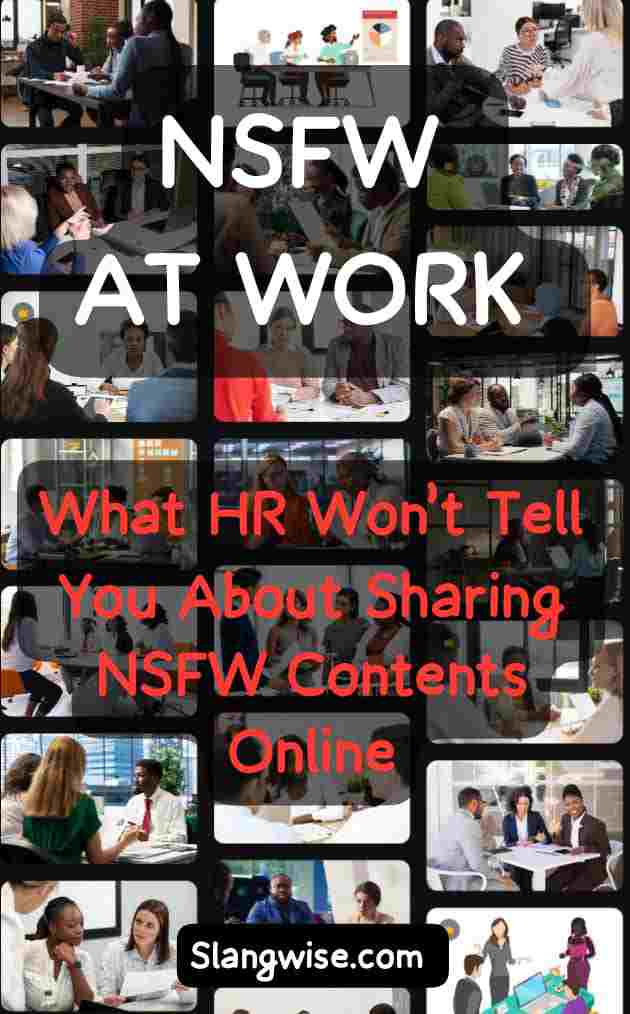If you work around people, on shared devices, or under a company email, NSFW isn’t just slang: it’s a workplace risk. Most employees treat NSFW as a casual tag. HR treats it like a potential incident.
This post explains the real-world consequences of sharing or viewing NSFW content at work, the unspoken etiquette that separates a warning from trouble, and a short checklist to keep careers intact.
Table of Contents
Why NSFW matters at work: the basic truth
NSFW stands for “Not Safe For Work.” It began as a courtesy to warn people before they opened explicit or disturbing material.
In an office, that courtesy becomes a legal and cultural matter: exposure to explicit content can create an uncomfortable workplace, trigger harassment complaints, or violate company policy.
The definition itself is widely accepted and listed in standard references.
NSFW Meaning, Learn what NSFW mean in slang and why people use it as a warning
Real consequences HR sees (and often doesn’t advertise)
HR teams aren’t interested in policing humor; they’re responsible for protecting the company and its people. A few real consequences that follow NSFW incidents:
- Disciplinary action up to termination. Employees have been fired for repeatedly viewing or sharing pornographic material on company devices or in shared spaces. High-profile cases across industries show that employers take this seriously.
- Claims of sexual harassment or hostile work environment. When coworkers are exposed to explicit material without consent, that can trigger harassment investigations and legal risk. Even a forwarded image can escalate if someone feels targeted. (See HR best practices on social media and acceptable use.)
- Security and productivity alarms. Visiting adult or risky sites on corporate hardware can introduce malware, create audit red flags, and lower productivity — all of which HR and IT track. Employers may discipline or restrict access based on these risks.
What HR really wants you to know (but won’t post as a meme)
HR documents that matter are often buried in employee handbooks or posted as vague “acceptable use” rules. Here are the practical points HR expects employees to follow, even if the HR rep won’t say them out loud in a company meeting:
- Company devices are not private. Anything on a work laptop, phone, or network can be audited. Assume your activity could be reviewed.
- Context matters more than intent. Accidentally opening something once is different from repeatedly sharing explicit material or directing it at coworkers. Repetition and targeting are what trigger severe discipline.
- Public or shared spaces are different. Viewing explicit material in a break room or shared office is worse than in a closed office, because others are exposed.
- Social media blurs lines. Posting NSFW content to a public personal account while identifying your employer or wearing branded apparel can bring consequences even if posted off-hours. HR watches reputation risk.
NSFW: You may have been using it the wrong way – here are 7 surprising ways to use NSFW the right way.
Legal and policy realities you should know
Companies typically codify rules about NSFW and social-media behavior in acceptable-use and social media policies. Many HR templates recommend explicit language on prohibited content and consequences.
At the same time, labor law and regulators sometimes limit how far employers can reach into employees’ personal speech: especially where union and labor rights are concerned. That tension means policies must be clear, consistent, and fair.
A few recent examples (why this isn’t hypothetical)
There are many public cases where employees lost their jobs after being found viewing or sharing explicit material on company systems.
These incidents are not limited to small companies, they span public agencies, airlines, and corporate settings. The takeaway is simple: visibility and scale matter. If activity is visible to coworkers or appears in logs, it quickly becomes HR’s problem.
Etiquette: how to handle NSFW like a professional
This is the part people skip, but it keeps careers safe. Follow these etiquette rules:
- When in doubt, don’t open it at work. If a post could embarrass a colleague or you wouldn’t show it in a meeting, save it for home.
- Avoid sharing links on work email or chat. Those systems are archived and monitored. Use personal accounts and private messages off company systems if you must share.
- Label clearly and add context. If something genuinely needs to be shared for work reasons (e.g., reporting an incident or discussing policy), preface it with a clear warning and explain why it’s relevant.
- Respect consent. Never direct explicit material at a coworker, even as a joke. Consent matters offline and online.
- Know your company policy. Read the acceptable use and social media sections in your handbook. If they’re vague, ask HR for clarification in writing.
Discover: how Gen Z uses NSFW from serious warnings to meme magic
Short checklist to avoid trouble
- Is this on a company device or network? → If yes, don’t open or share.
- Could someone else see or overhear this? → If yes, don’t open it.
- Is this necessary for work? → If no, save it for personal time.
- Would it reflect badly on the company if seen publicly? → If yes, don’t post it anywhere tied to your job.
- If it’s work-related (investigation/reporting), did you add a clear warning and context? → If no, add one.
A note for managers and creators
Managers should model behavior and make policies clear. Creators and marketers who straddle personal and company identity must be especially careful: an NSFW post made in a personal voice can still harm a brand.
HR often tolerates mistakes, but repeated behavior or anything that targets colleagues rarely ends well.
Final word – A practical advice from an observer
I’ve reviewed dozens of workplace policies and helped translate them into plain English for teams. My view is simple: NSFW is fine as a shorthand in private, but in the workplace it becomes a serious label with consequences.
Treat it with the care it deserves. If you value your job and your reputation, handle explicit content off company systems, outside shared spaces, and with clear boundaries.
FAQs
Yes. Company devices, networks, and email are typically auditable. Even a single incident can trigger action if it creates a hostile environment or violates policy; repeated or targeted behavior raises the stakes. Check your employee handbook and, if unclear, ask HR in writing.
Don’t forward it. Tell the sender to stop, save the message (screenshot or preserve logs), and report the incident to HR or your manager if it’s unwelcome or repeated. If you feel harassed or unsafe, escalate immediately.
Potentially: especially if your account links you to the company (profile, photos in branded gear, or public ties). Off-hours posts that harm company reputation can still be addressed under social-media or conduct policies. When in doubt, separate personal and professional identities and avoid brand association.
Document what happened (time, sender, context), report it to HR and/or IT, and ask for confidentiality if needed. If the content appears to be malicious (malware, phishing) include IT so they can secure systems and logs.
Set clear, written policies; model appropriate behavior; provide training on acceptable use and consent; maintain confidential reporting channels; and apply consequences consistently. Clear communication prevents confusion and protects both employees and the organization.
Selected sources: Merriam-Webster definition of NSFW; SHRM guidance and social media policy templates; reporting on workplace terminations related to explicit content.

